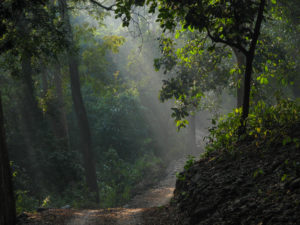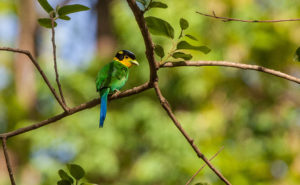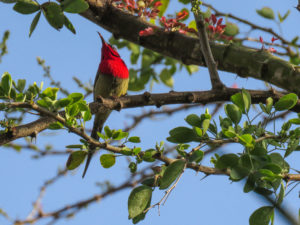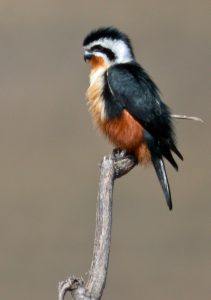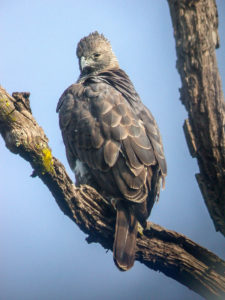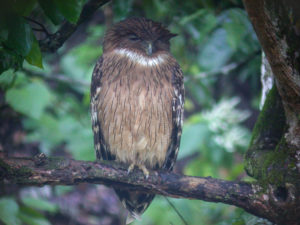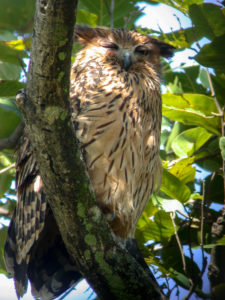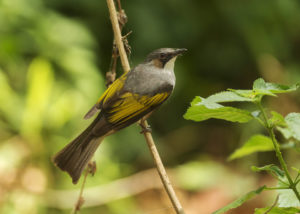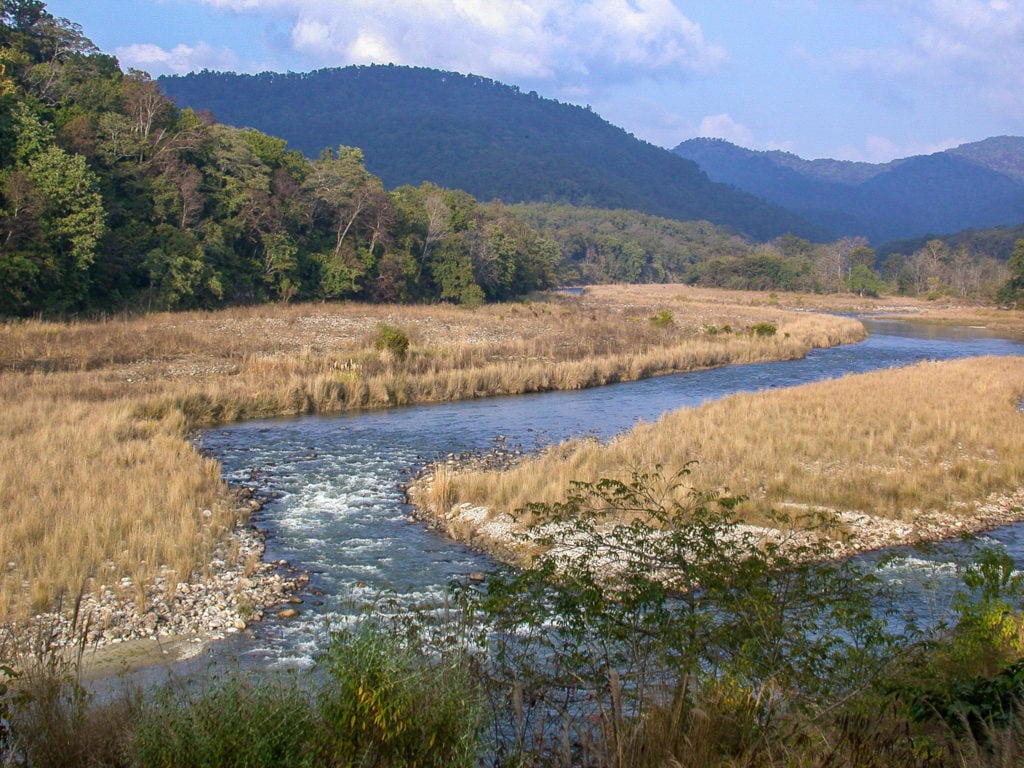Jim Corbett National Park, officially Corbett Tiger Reserve—and popularly known purely as Corbett—is a fabulous wildlife destination in northern India.
Nestled at the foothills of the mighty Himalayas, Corbett is a spectacular landscape, especially famous for sightings of Bengal Tiger and Asian Elephants, and its wilderness. Apart from big cats and other large mammals, the mountains and the foothills harbour diverse avifauna, such as Ibisbill, Lesser Fish Eagle, Tawny Fish Owl, Great Slaty Woodpecker, Wallcreeper and Himalayan Rubythroat. It attracts flocks of birdwatchers from around the globe every year. The scenic combination of hills, Sal forests and the terai landscape (swamps and grasslands between the lower foothills of the Himalayas and the plains), offer a variety of habitats for birds.
At least 512 bird species[1], including migrants and residents, have been reliably recorded in and around Corbett.
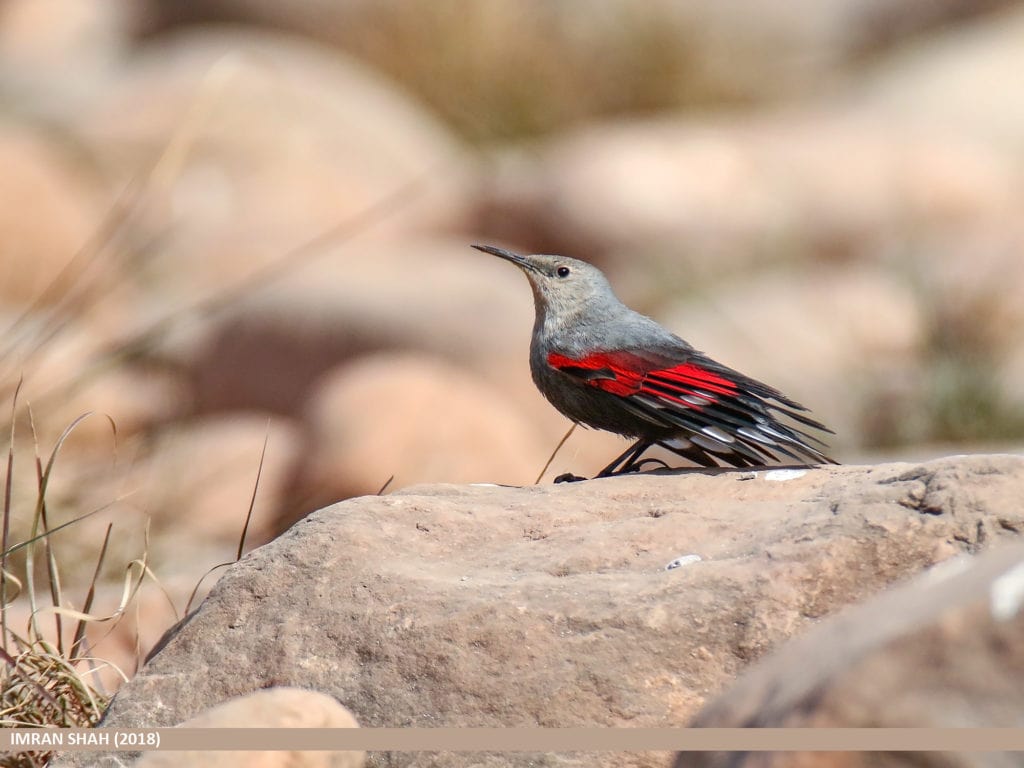
| Hotspot | Corbett National Park |
| District | Nainital |
| Other hotspots | Dhikala, Bijrani, Jhirna, Dhela, Kosi River, Garjiya, Mohan, Pawalgarh Conservation Reserve |
| Checklist | Uttarakhand |

Location and Habitat
Corbett National Park is located near Ramnagar, a city in the state of Uttarakhand. Dominated by pastoral communities, the country-side landscape extends to the foothills of the Siwalik (Shivalik) mountain range of the outer Himalaya.
The elevational gradient ranging from about 400m to 1,220m, and spanning diverse habitats, is home to a great variety of bird species. The grasslands—locally known as chaurs—adjoining the river Kosi and river Ramganga, are riparian and grassy habitats at the lowest points. Many bird species from high altitudes descend to these lower elevations, and the foothills of the Himalayas, during winter months; Ibisbill is a prime example. Blue-capped and White-capped Redstarts, Spotted and Little Forktails, and Brown Dipper hopping from one stone to another and dipping in the water, all catch attention.
Intermediate patches between river banks and grasslands are ideal for the Ibisbill, as well as Great Thick-knee and Northern Lapwing—it occurs in just a few places in the northern parts of India unlike its wide distribution in Europe, and is a key target bird for Indian birders! Black Francolins, Rosy Pipits, various shrikes and Pied Harriers, can be seen in these grasslands.
The riparian forests are distinct and consist of Khair and Shisham vegetation that stands in the sandy and gravelly areas skirting the water bodies.
Sal (Shorea robusta) is the dominant species forming the canopy of the forest. The tall and handsome sal trees allow other tree species to form the multi-layered forest under their shade. This provides excellent shelter choices for mammals, birds and lesser fauna. Sal forests are the habitats for Great and Oriental Pied Hornbills, Red-billed Blue Magpie, several woodpeckers, Kalij Pheasants, green-pigeons (including Wedge-tailed, Yellow-footed, and the scarcer Pin-tailed and Orange-breasted), laughingthrushes (White-crested, White-throated and Streaked), and the beautiful Long-tailed Broadbill.
As one ascends the mountains, the forest types change from the broad-leaved, dipterocarp forests of the foothills in Corbett itself to more coniferous vegetation in surrounding areas. Beyond Corbett, as one travels to higher elevations, vast tracts of Chir pine and oaks dotted with Rhododendron trees, and with snow in the winter, provide a different, easy-to-access, bird habitat.
History
Corbett is a milestone in forest conservation in Asia. It is not only the first National Park in India, but in all of Asia. In 1936, under British rule in India, about 300 sq km area of forest was protected from hunting and killing of animals, and was named as Hailey National Park. It was named after the then Governor of the United Provinces—Sir Malcolm Hailey. Twenty years later, it was renamed Jim Corbett National Park, in honour of the famous naturalist and author of many books that depict his experiences in the wilderness of the Himalayas, and his encounters with wild cats.
The old infrastructure which had served as camp sites during game hunting and forest management operations in British era, now stand with pride to offer nature experiences to tourists. The century-old guest houses situated deep inside the forest offer a panoramic, picturesque view of the valleys, rivers and the snow-capped Himalayan ridgeline as a backdrop.
Jim Corbett’s bungalow is now turned into a heritage museum in Kaladhungi— located about 30km away from Ramnagar, on the road to Nainital. The well-preserved field notes, journals, paintings, sketches, trophies of ‘man-eater’ tigers and maps by Corbett, give glimpses in to his personality and life history.
Birding in Corbett

Corbett Tiger Reserve is spread over a 500 sq km area with a suite of wildlife habitats ranging from open grasslands to dense forests on mountain slopes. It is recognised as an Important Bird Area (IBA) by BirdLife International. The park has five tourist zones that also differ in their landscape and habitat features, and hence provide different sets of bird assemblages.
Unfortunately, birding is not possible on foot except for in the grounds of the various rest houses. There is good reason for this, however. In 1985, the well-known British birdwatcher David Hunt was leading a tour when he left his group to investigate the sound of some mobbing birds, suspecting an owl. Almost immediately he stumbled upon a female tiger, with three cubs nearby, and was attacked and killed.
Dhikala Zone
The most exciting zone for safaris, both for birds as well as other wildlife, is Dhikala. The chaurs of Dhikala are iconic in the terai landscape. Wildlife sightings here can be mesmerising, ranging from large terrestrial mammals, aquatic mammals such as otters, reptiles including Gharial and Marsh Mugger crocodiles, amongst other regulars.
Birding in Dhikala is great for grassland species. One of the main highlights, Hodgson’s (or White-throated) Bushchat, is now very scarce, but a jeep safari through the grasslands may still encounter one or two, along with Bright-headed Cisticola and Chestnut-eared Bunting. Richard’s Pipits and Rosy Pipits are regular winter migrants, and larks and other buntings may be seen in flocks in the grasslands.
Very frequently seen birds include multiple species of owls—many of which will show clearly in daylight—barbets, pigeons, parakeets, pheasants, and open habitat raptors such as the endangered Pallas’s and Lesser Fish Eagles, Pallid Harrier, Greater Spotted Eagle, Slender-billed Vulture, Collared Falconet, etc.
At dusk there is an outside chance of the very rare Eastern Grass Owl quartering over the grasslands, before the calls of Large-tailed Nightjar resonate throughout the night.
Bijrani Zone
The Bijrani zone is another popular destination for jeep safaris. The beautiful habitat here is a mix of sal forest, stretches of grasslands and streams. The picturesque landscape of Bijrani resembles that of Dhikala in many ways, including the wildlife. From this zone a remarkable 326 species of birds (mostly seen from a jeep, because there is limited access on foot!) have been reported. Bijrani is a good place to look for waders including Ibisbill and River Lapwing, forest birds such as green pigeons, woodpeckers, barbets and hornbills, and eagles and vultures.
Jhirna Zone, Dhela Zone and Sonanadi Wildlife Sanctuary
Year-round tourism is open in the Jhirna, Dhela and Sonanadi zones. These places are well-known for wildlife sightings. Most bird species reported from Corbett can be seen in these zones. The mix of dense forest, grasslands and riverine patches, provide good birding habitats. From the infrequently visited Dhela zone, 217 species are reported on eBird.
Garjiya Devi (Girija Devi) Temple
Easily accessible from Ramnagar and the various resorts along the Kosi River, the Garjiya Devi temple is a well-known vantage point that often produces Wallcreeper, and this stretch of the river is favoured by Ibisbill. There are usually Plumbeous and White-capped Redstarts, Brown Dippers and Crested Kingfishers here also.
Mohan
A little further north is Mohan (or Mohaan), a beautiful village on the banks of the Kosi River, just outside of the official Corbett National Park boundary. Importantly this allows access on foot, and excellent birding therefore. The riverine stretches offer possible sightings of the elusive Ibisbill, with River Lapwing and Wallcreeper regular.
The tall cliffs and mud-walls along the river bank are good for spotting vultures such as Himalayan and Eurasian Griffons, and Egyptian Vulture. The forest stretch from here to Bhakrakot, and on to Marchula, on the banks of the Ramganga River, is also very good, with a chance of Long-billed Thrush, tesias, Nepal Wren-Babbler (or Cupwing), and White-browed Shortwing—now split as Himalayan Shortwing.
Kumeria Reserve Forest
The entire area past Mohan in the direction of Ranikhet and the Himalayas, to Kumeria, can provide fantastic birding with excellent forest and access to the Kosi River. Tawny Fish Owl is often present near Kumeria.
Other Birding Sites
Pawalgarh Conservation Reserve (300–700m)
Pawalgarh Conservation Reserve allows trekking and birding along the lively River Sitabani, with a birdlife typical of Corbett itself. Pawalgarh successfully hosted the Uttarakhand Bird Festival in 2017 and 2020.
This particular area is a hotspot for woodpeckers, with 17 woodpecker species largely found in the sal forests, including the world’s largest Great Slaty Woodpecker—a difficult species to find in India, but the Corbett area is the most reliable.
Many species that breed in the high altitudes of the Himalayas migrate to this foothill area. These include Chestnut-headed Tesia, Grey-hooded Warbler, Whistler’s Warbler, Orange-bellied Leafbird, Grey-winged Blackbird and Bar-tailed Treecreeper. Look out also for Rufous-bellied Eagle, Blue-bearded Bee-eater, White-bellied Erpornis and, in the summer, Hooded Pitta. Nocturnal sightings year-round can include Spot-bellied Eagle Owl.
Sattal (1,300m)
One advantage of birding in this area of Uttarakhand is the ease of access to ‘proper’ high-altitude birding, and a quite different bird community to that encountered in the lowlands and plains. Just a short drive from Corbett National Park brings you to the Nainital area, and the especially bird-rich locations of Sattal and Pangot.
Sattal is a mid- to high-elevation birding hotspot, reached as one starts to scale the mountains from Ramnagar. Less than three hour’s drive from Corbett, Sattal is a particular highlight for those interested in bird photography. Himalayan specialities to watch here include Collared Owlet, Chestnut-bellied Nuthatch, Red-billed Leiothrix, Green-tailed Sunbird and Chestnut-headed Tesia, to name but a few.
Pangot (2,000m)
Pangot (Pangoot) is a high-altitude birding spot at approximately 2000m elevation. The forests are mixed and dominated by Oak, Pine and Rhododendron. The higher stretches of Pangot are characterised by more sub-alpine habitats, and provide excellent opportunities to see both Koklass and Cheer Pheasants. Otherwise Pangot supports a brilliant variety of Himalayan species, including Bearded and Cinereous Vultures, minlas, yuhinas, Striated Laughingthrush, Collared Grosbeak, Brown Bullfinch, Black-throated Accentor, and Fire-breasted Flowerpecker. This is the best place to see the very rare Grey-crowned Prinia.
Other Wildlife
Mammals
Famous for wild cats, Corbett National Park is a home for many mammals, butterflies and moths and reptiles.
Corbett supports a healthy population of Tiger—and you have a good chance of seeing one if your trip includes a few jeep safaris—and other wild cats such as Leopard, Jungle Cat, Leopard Cat and the elusive Fishing Cat. The park is also a part of the Shivalik Elephant Reserve that aims to safeguard Asian Elephants in the landscape, through Project Elephant.
The rich mammalian diversity also includes Asiatic Wild Dog, Sloth Bear, Yellow-throated Marten, various otters and mongooses, Wild Boar, Spotted Deer, Hog Deer, Sambar, Nilgai, Barking Deer, Pangolin and abundant primates, including Rhesus Macaque and Terai Grey Langur (with Nepal Grey Langur at higher altitudes). The deciduous forest patches and surrounding agricultural land support Golden Jackal, Chinkara and civets.
Reptiles
The rivers Ramganga and Kosi are home to fish-eating Gharials, Marsh Mugger crocodiles, monitor lizards and at least 12 species of freshwater turtles and tortoises, including Sal Forest Tortoise. Pythons and King Cobras occur in the Shivaliks, along with the “big four” snakes, i.e. Indian Cobra, Common Krait, Russell’s Viper and Saw-scaled Viper. Ophidiophobes should not worry, however, for it is very rare to come across these unless you are specifically hunting for them!
Butterflies and Moths
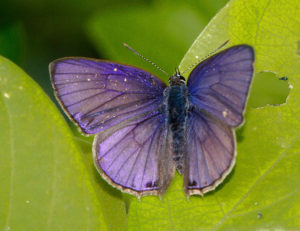
Corbett National Park and the surroundings are rich in lepidopteran diversity. In 2016, three species of butterflies were newly discovered in Nainital district: the rare Indecorous Five-ring, Newar Three Ring and Common Ciliate Blue.
The rich diversity of butterflies and moths in the Corbett landscape attracts numerous naturalists. In collaboration with local communities, lepidopterists organise the Pawalgarh Titli Utsav (Butterfly Festival) in winters and summers.
Logistics
Getting There
Delhi is the nearest metropolitan city for domestic and international tourists. Ramnagar is situated about 260 km from Delhi and well connected by rail and road. Ramnagar is the nearest railway station with frequent trains starting from Delhi, including convenient overnight trains arriving in time for early morning birding or a safari.
Weather and Timing
The weather is quite stark in winters and summers. October to February is the winter season, when it is cold and with the possibility of light showers. The temperature drops to an average low of 7 degrees Celsius and January is the coldest month—you will need to wrap up warm for early mornings in an open jeep! Winter and spring, particularly December to March, is very good for birding as many migratory birds are present.
March to June is the dry and hot summer, with temperatures rising to 35 degrees Celsius. Birding can be very good if you don’t mind the scorching sun, and preferably have a comfortable resort with swimming pool to cool down later!
The core zone of the park is closed during the monsoon (June to October) for tourists. However, two safari zones—Jhirna and Dhela, and Sonanadi Wildlife Sanctuary—are open from July onwards. Many of the best birding areas are outside the park itself as well, and not restricted. From October, Bijrani gate is open for safaris, and Dhikala opens in mid-November. The Sitabani Forest Zone, which is in the buffer area, is open year round. To enter the park, jeep safaris and canter (open bus) safaris are available from six different gates.
Accommodation and Food
Being a famous wildlife destination, Corbett National Park and surroundings provide a wide range of accommodation facilities to suit all budgets. The park administration has multiple rest houses in the core and buffer areas of the park. The old British camps are revamped into rest houses in the heart of the forest, and staying in these makes for an unforgettable experience. All the resorts and most rest houses are well equipped and with attached bathrooms and western-style toilets. During winters, they provide room heaters, and the camp-fire on a chilly night in the jungle is a must-do experience.
The hamlets in the Pawalgarh Conservation Reserve also host tourists in their traditional and cosy huts and homestays. Many campsites have a facility to pitch a tent on the premises.
Useful Trip Reports
Many trip reports giving basic information are available. The following will particularly whet your appetite for a visit to Corbett National Park!
- Birding Northern India, Måns Grundsten—a successful birding trip, with detailed site maps
- Bharatpur, Pangot and Corbett, Daniel Branch—lovely photos of some key birds
- Birding and Mammaling North and Central India, Uffe Gjøl Sørensen—detailed bird and mammal notes from a wide-ranging trip in North India
Corbett never fails to disappoint, even after multiple visits, and the well-established logistics make it an ideal place to visit for a first-time visitor to India. The video below gives a taster of a Corbett safari. Consider our Classic North India Birds and Wildlife tour for this, or a short birdwatching break from Delhi, and do contact us for any more information.
- An “official” Zoological Survey of India checklist quotes 685 species, unfortunately riddled with mistakes, including many species that have never occurred!↩︎
